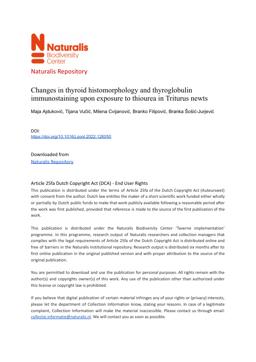2022-09-08
Changes in thyroid histomorphology and thyroglobulin immunostaining upon exposure to thiourea in Triturus newts
Publication
Publication
Zoology , Volume 155 - Issue 126050
Amphibians are useful bioindicators for monitoring aquatic health and the influence of xenobiotics such as endocrine disrupting chemicals. Because aquatic ecosystems experience the majority of global pollution, aquatic organisms are most exposed and vulnerable to endocrine disruptors. Furthermore, penetration of endocrine disruptors into aquatic organisms especially in amphibians is even easier because of more permeable skin, resulting in high bioavailability and bioaccumulation of chemicals. One of the most potent endocrine disruptors is thiourea, which chemically blocks the synthesis of thyroid hormones and prevents metamorphosis in amphibians. We investigated the influence of thiourea on histomorphology of the thyroid gland in Triturus newts at the metamorphic stage, when thyroid hormone concentrations should reach their maximum level. Chronic exposure to thiourea induced hypertrophy and hyperplasia of follicular cells as well as a significant reduction of interstitial tissue. The intensity of the thyroglobulin immunostaining signal significantly decreases upon chronic exposure to thiourea. Successful cross-reactivity of human primary antibody in immunochemical detection of thyroglobulin in Urodela confirms potential homology in thyroglobulin structure throughout the vertebrates.
| Additional Metadata | |
|---|---|
| , , , | |
| doi.org/10.1016/j.zool.2022.126050 | |
| Zoology | |
| Organisation | Staff publications |
|
Ajduković, Maja, Vučić, T., Cvijanović, Milena, Filipović, Branko, & Šošić-Jurjević, Branka. (2022). Changes in thyroid histomorphology and thyroglobulin immunostaining upon exposure to thiourea in Triturus newts. Zoology, 155(126050). doi:10.1016/j.zool.2022.126050 |
|
